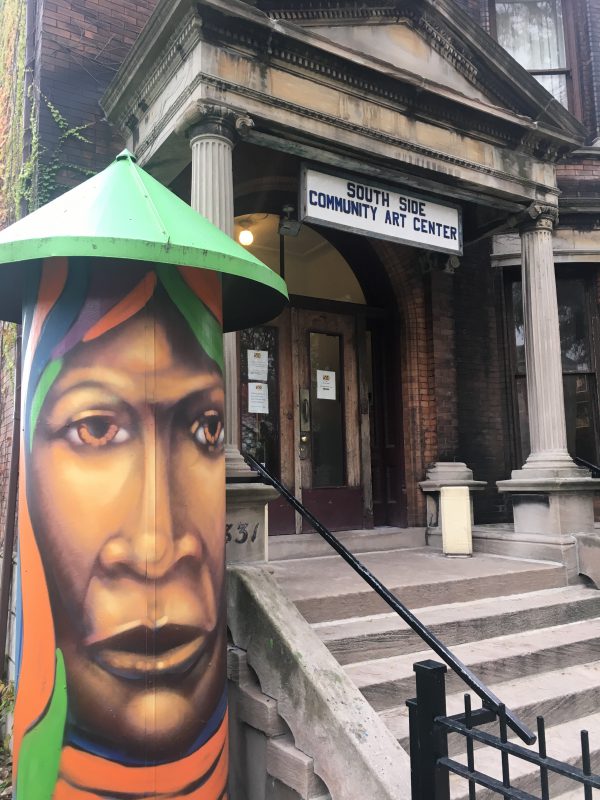At a recent press conference held within the historic confines of the South Side Community Art Center (SSCAC), 3831 S. Michigan Ave., the National Trust for Historic Preservation recognized the Bronzeville landmark for what it truly is — a national treasure.
 Since its dedication in 1941 by First Lady Eleanor Roosevelt, the SSCAC has served as a beacon of African-American art, culture, poetry in Chicago for more than 75 years. The SSCAC is the sole art center to consistently remain open out of 100 from President Franklin Roosevelt’s Works Progress Administration Arts Project Initiative. Legendary artists such as Dr. Margaret Burroughs, Gwendolyn Brooks—the first African American woman to win the Pulitzer Prize—and Life magazine photographer and filmmaker Gordon Parks have all walked the halls of the SSCAC throughout its existence.
Since its dedication in 1941 by First Lady Eleanor Roosevelt, the SSCAC has served as a beacon of African-American art, culture, poetry in Chicago for more than 75 years. The SSCAC is the sole art center to consistently remain open out of 100 from President Franklin Roosevelt’s Works Progress Administration Arts Project Initiative. Legendary artists such as Dr. Margaret Burroughs, Gwendolyn Brooks—the first African American woman to win the Pulitzer Prize—and Life magazine photographer and filmmaker Gordon Parks have all walked the halls of the SSCAC throughout its existence.
The National Trust for Historic Preservation, a privately funded non-profit that works to preserve historic sites, is no stranger to Chicagoland. In years past the NTHP recognized the Pullman National Monument, the Frank Lloyd Wright’s Unity Temple, and the Prentice Women’s Hospital as national treasures.
Barb Pahl, senior vice president of NTHP, said the national treasure designation is the NTHP’s highest honor of which there are less than 100 current sites. She said NTHP’s goal is to work alongside the SSCAC to ensure the building and its works are preserved and restored in addition to work to promote the SSCAC to a broader audience. She said NTHP will now move forward to ensure the SSCAC is listed on the National Register of Historic Places.
“The Center’s distinguished role in Chicago and across the country is why I am proud to say today that the South Side Community Arts Center is our newest national treasure,” said Pahl. “This designation means that we believe that the South Side Community Art Center is a part of our nation’s history book and must be saved and live on to be a source of inspiration for this generation and the next. The South Side Community Arts Center stands at the center of our work to identify and preserve the places that tell the often overlooked stories of African Americans and their many cultural contributions to our nation’s fabric.”
Twyler Jenkins, co-president of the board of directors at the SSCAC, a board member for five years, said the NTHP’s national treasure designation has been two years in the making. She said the board is working on what the future of the SSAC will look like moving forward, including thoughts of expansion, development of a capital campaign, and strategic planning for the foreseeable future. She said the designation brings greater interest and exposure not only locally but internationally.
“We certainly want to become a jewel that is on the South Side of Chicago and throughout the World,” said Jenkins. “What Margaret Burroughs and the other founders did when they founded this organization 76 years ago was unprecedented, and for us to still be here is still unprecedented so I think what this day does is allow us to continue that legacy.”
Jenkins stated firmly that there’s value in preserving Chicago’s African-American art and culture. She noted while a good deal of work may be ahead, the board is ready to take on the challenge.
“We can’t allow this to be taken away from us, we can’t allow this story to not be around to tell our future generation, we can’t allow this to be lost in any shape, form, or fashion and not only the building but the archives,” said Jenkins.
The impact of the SSCAC goes beyond its history and now to the next generation of artists.
Masequa Myers, executive director of SSCAC, said because of art’s ability to impact the lives of young people, the SSCAC is relevant and will continue to be relevant now and in the years ahead.
“Art speaks from the heart, art opens up the lines of communication, and we know that art can heal,” said Myers.
Alreona Phillips, a student at Chicago Military Academy at Bronzeville, now in her second year in the Teen Talk Theater program facilitated by After School Matters held at the SSCAC, demonstrates the landmark’s future on the next generation of artists. Initially, Phillips said she wasn’t aware of the historical relevance the SSCAC, but she has recently become more familiar. The Chatham native said she likes to act and was the assistant director of a play, “Faith,” last year.
Phillips said the SSAC provides a space where she and the youth in attendance can be themselves. She acknowledged the encouragement she’s received from the SSAC to push herself to be the best she can be.
“Yes, we have ourselves but you need people to come along and people of our color to show you that your color doesn’t mean anything… your race, sexual orientation, gender, or your age don’t mean anything; if you want something, you can do it,” said Phillips. “You actually want to go out and create things, and being here I’ve wanted to create my own foundations and my own clubs and groups to help other people.”
Phillips said she has recruited multiple friends from her high school who frequently visit the SSCAC for a variety of events.
For more information about the South Side Community Art Center, visit sscartcenter.org/.
For more information about the National Trust for Historic Preservation, visit savingplaces.org/we-are-saving-places#.WgS8T_lSzIU.
